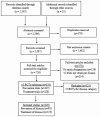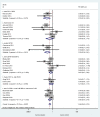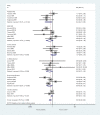Strain-Specificity and Disease-Specificity of Probiotic Efficacy: A Systematic Review and Meta-Analysis
- PMID: 29868585
- PMCID: PMC5949321
- DOI: 10.3389/fmed.2018.00124
Strain-Specificity and Disease-Specificity of Probiotic Efficacy: A Systematic Review and Meta-Analysis
Abstract
Background: As the use and diversity of probiotic products expands, the choice of an appropriate type of probiotic is challenging for both medical care professionals and the public alike. Two vital factors in choosing the appropriate probiotic are often ignored, namely, the probiotic strain-specificity and disease-specificity for efficacy. Reviews and meta-analyses often pool together different types of probiotics, resulting in misleading conclusions of efficacy.
Methods: A systematic review of the literature (1970-2017) assessing strain-specific and disease-specific probiotic efficacy was conducted. Trials were included for probiotics with an identifiable strain (either single strain or mixtures of strains) that had at least two randomized, controlled trials for each type of disease indication. The goal was to determine if probiotic strains have strain and/or disease-specific efficacy.
Results: We included 228 trials and found evidence for both strain specificity and disease specificity for the efficacy of specific probiotic strains. Significant efficacy evidence was found for 7 (70%) of probiotic strain(s) among four preventive indications and 11 (65%) probiotic strain(s) among five treatment indications. Strain-specific efficacy for preventing adult antibiotic-associated diarrhea was clearly demonstrated within the Lactobacillus species [e.g., by the mixture of Lactobacillus acidophilus CL1285, Lactobacillus casei LBC80R, and Lactobacillus rhamnosus CLR2 (Bio-K+®), by L. casei DN114001 (Actimel®) and by Lactobacillus reuteri 55730], while other Lactobacillus strains did not show efficacy. Significant disease-specific variations in efficacy was demonstrated by L. rhamnosus GG and Saccharomyces boulardii CNCM I-745, as well as other probiotic strains.
Conclusion: Strong evidence was found supporting the hypothesis that the efficacy of probiotics is both strain-specific and disease-specific. Clinical guidelines and meta-analyses need to recognize the importance of reporting outcomes by both specific strain(s) of probiotics and the type of disease. The clinical relevance of these findings indicates that health-care providers need to take these two factors into consideration when recommending the appropriate probiotic for their patient.
Keywords: Clostridium difficile; Lactobacillus; Saccharomyces; antibiotic-associated diarrhea; disease specificity; meta-analysis; pooling data; probiotic strains; strain specificity.
Figures





Similar articles
-
Choosing an appropriate probiotic product for your patient: An evidence-based practical guide.PLoS One. 2018 Dec 26;13(12):e0209205. doi: 10.1371/journal.pone.0209205. eCollection 2018. PLoS One. 2018. PMID: 30586435 Free PMC article.
-
The Acid-Dependent and Independent Effects of Lactobacillus acidophilus CL1285, Lacticaseibacillus casei LBC80R, and Lacticaseibacillus rhamnosus CLR2 on Clostridioides difficile R20291.Probiotics Antimicrob Proteins. 2021 Aug;13(4):949-956. doi: 10.1007/s12602-020-09729-5. Epub 2021 Jan 25. Probiotics Antimicrob Proteins. 2021. PMID: 33492661
-
Primary prevention of Clostridium difficile infections with a specific probiotic combining Lactobacillus acidophilus, L. casei, and L. rhamnosus strains: assessing the evidence.J Hosp Infect. 2018 Aug;99(4):443-452. doi: 10.1016/j.jhin.2018.04.017. Epub 2018 Apr 24. J Hosp Infect. 2018. PMID: 29702133 Review.
-
Lactobacillus acidophilus CL1285, Lactobacillus casei LBC80R, and Lactobacillus rhamnosus CLR2 (Bio-K+): Characterization, Manufacture, Mechanisms of Action, and Quality Control of a Specific Probiotic Combination for Primary Prevention of Clostridium difficile Infection.Clin Infect Dis. 2015 May 15;60 Suppl 2:S135-43. doi: 10.1093/cid/civ179. Clin Infect Dis. 2015. PMID: 25922399 Review.
-
Probiotics and prevention of Clostridium difficile infection.Anaerobe. 2017 Jun;45:114-119. doi: 10.1016/j.anaerobe.2016.12.007. Epub 2016 Dec 14. Anaerobe. 2017. PMID: 27988389 Review.
Cited by
-
Meta-analysis of 16S rRNA microbial data identified alterations of the gut microbiota in COVID-19 patients during the acute and recovery phases.BMC Microbiol. 2022 Nov 14;22(1):274. doi: 10.1186/s12866-022-02686-9. BMC Microbiol. 2022. PMID: 36376804 Free PMC article.
-
Shaping the Future of Probiotics: Novel Methodologies, Applications, and Mechanisms of Action.Microorganisms. 2023 Dec 29;12(1):73. doi: 10.3390/microorganisms12010073. Microorganisms. 2023. PMID: 38257900 Free PMC article.
-
Probiogenomics of Lactobacillus delbrueckii subsp. lactis CIDCA 133: In Silico, In Vitro, and In Vivo Approaches.Microorganisms. 2021 Apr 14;9(4):829. doi: 10.3390/microorganisms9040829. Microorganisms. 2021. PMID: 33919849 Free PMC article.
-
Probiotics Do Not Alter the Long-Term Stability of the Supragingival Microbiota in Healthy Subjects: A Randomized Controlled Trial.Pathogens. 2021 Mar 24;10(4):391. doi: 10.3390/pathogens10040391. Pathogens. 2021. PMID: 33805208 Free PMC article.
-
Fungal feelings in the irritable bowel syndrome: the intestinal mycobiome and abdominal pain.Gut Microbes. 2023 Jan-Dec;15(1):2168992. doi: 10.1080/19490976.2023.2168992. Gut Microbes. 2023. PMID: 36723172 Free PMC article. Review.
References
-
- Hill C, Guarner F, Reid G, Gibson GR, Merenstein DJ, Pot B, et al. Expert consensus document: the international scientific association for probiotics and prebiotics consensus statement on the scope and appropriate use of the term probiotic. Nat Rev Gastroenterol Hepat (2014) 11(8):506–14.10.1038/nrgastro.2014.66 - DOI - PubMed
LinkOut - more resources
Full Text Sources
Other Literature Sources
Research Materials

